


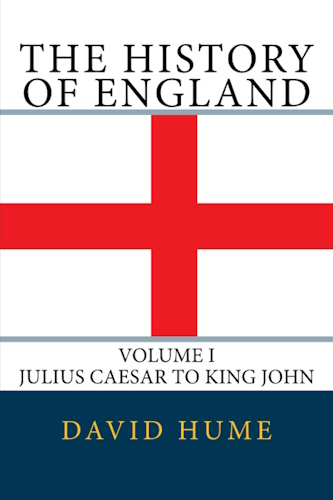
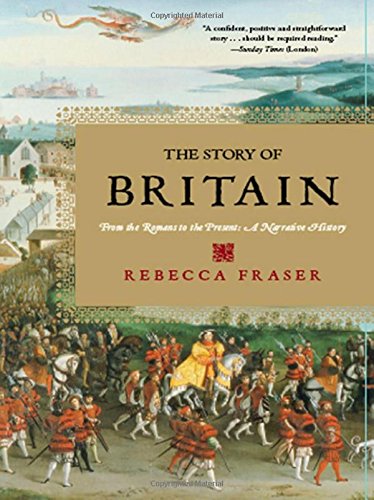



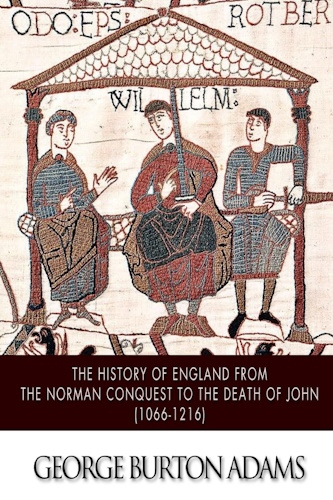

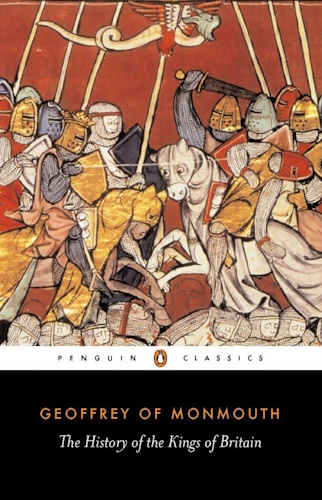

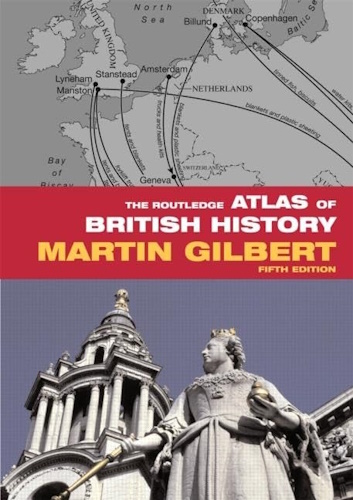

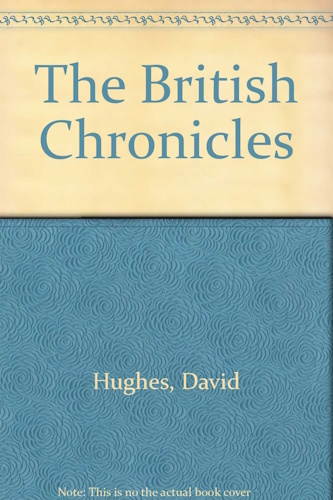
The Old English Royal House
by David Hughes
2005
Recovered from WayBackMachine
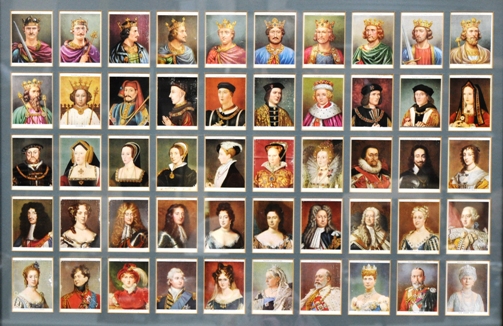
THE OLD ENGLISH ROYAL HOUSE
The Welsh, English, and Scots, struggled against the Vikings and eventually overcame them, and the Viking kingdom[s] in Britain gave way to the newly founded kingdoms of Scotland, Wales, and England, which began the High Middle Ages in Britain. See: The Viking Age.
The Kingdom of England was founded Year 886 by ALFRED "THE GREAT," the grandson of EGBERT OF WESSEX, the last Anglo-Saxon Bretwalda, who, the heir of the old Anglo-Saxon bretwaldas, defeated the Vikings and liberated England from their domination and founded a national state and monarchy to become the first "King of England."
The throne of England has been occupied for more than a thousand years by the descendants of Alfred "The Great." Some monarchs have been good; while some have been bad. However, each one whether good or bad has left their mark on the progress of English History which has contributed to the political development of England throughout the ages.
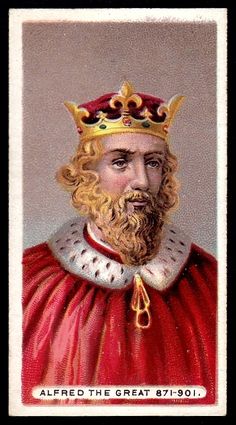
ALFRED "THE GREAT" is considered one of the most enlightened rulers of the Middle Ages. He, just like King Arthur, has attained legendary, even mythic stature; and he shares with King Arthur the role of a savior-king who delivers his people from foreign conquerors. Alfred was the fifth and youngest son of King Ethelwulf of Wessex and his first wife. His mother died soon after his birth. As a youth Alfred accompanied his father on a three-year tour of foreign capitals. In Rome, in 853, the pope, Leo IV, accepted Alfred as his "god-son" and administered the rite of confirmation to him. Later, Asser, Bishop of Sherbourne, in his biography of Alfred "The Great," claimed that he was also consecrated to future kingship by the pope, however, the occurrence of his later succession could hardly have been foreseen then since Alfred had four older brothers. Three of Alfred's older brothers reigned in turn as King of Wessex. His oldest brother, Athelstan, served as regent during his father's absence. He was murdered in 855 by his brother, Ethelbald, who was Ethelwulf's second son, who thereupon usurped the throne. The next year, on his father's return to England, the old king, Ethelwulf, finding little support, was obliged to abdicate in favor of his son, Ethelbald, who refused to concede the throne. The ex-king, Ethelwulf, who had re-married during his travels, retired onto an estate with his bride. He died two years later, and his young widow was taken to wife by his son. The marriage of Ethelbald to his step-mother caused a scandal, and by the next year Ethelbald had been forced by the Church to annul the marriage. Ethelbald died without issue in 860, and was succeeded by his brother, Ethelbert. The Vikings returned to England with a vengeance during the reign of Ethelbert. Most of his reign Ethelbert spent fighting the invaders. Ethelbert died in 865/6, and, survived by only a daughter, was succeeded by his brother, Ethelred. Ethelred faced the full fury of the Viking storm. He fought a fierce and frenzy defense throughout his reign. Ethelred was mortally wounded in battle at Merton in 871 and died shortly after. The Vikings attacked again the day of his funeral at Wimborne and overran the country. Ethelred was survived by two sons, Ethelwald and Ethelhelm, who were both minors, however, with the country overrun by foreign invaders, the Wessex nobles preferred to have an adult as king rather than a child and entreated Alfred to be their king. Alfred as the youngest of five brothers had never expected to be king and had entered the service of the Church but had not yet taken any vows; and it was only after much persuasion that Alfred [age 23] was prevailed upon by the Wessex nobles to accept the crown. The Vikings attacked again immediately after Alfred's consecrated to the kingship, and Alfred was occupied over the next seven years in a desperate struggle against the Vikings. Several battles and numerous skirmishes were fought over the next few years, the outcomes of which were indecisive. Alfred turned back the Viking Army in battle at Wilton in 871, which victory was followed by the defeat of the Viking Fleet in a naval battle off the coast at Swanage in 875. Alfred won another victory over the Vikings in 876 at Wareham. These victories were followed by an uneasy and short-lived truce. Then, in a surprise attack during the winter of 877/878, the Vikings again overran Wessex and scattered the Wessex Army, whereupon, Alfred was reduced to wandering among the woods and swamps of England living off the land with only a few retainers. Alfred set-up his headquarters in a cowherd's hut on the Isle of Athelney in the fens of Somerset which was an inaccessible marshy area where the Vikings could not find him. From there Alfred began to strike out at the Vikings in a campaign of guerrilla warfare. Alfred emerged from his hideout the spring of 878 and rallied his countrymen to arms, and launched a counter-offensive against the Vikings. He undertook the systematic liberation of the country from its foreign occupiers. Alfred defeated the Vikings at Edington, Wiltshire, in 878; and, in a string of victories, by 880 had completely driven the Vikings out of Wessex. The Vikings continued their attacks over the following years but were time and time again defeated by Alfred, who retook London in 885 and pushed the Vikings back and forced the partition of the country between the English and the Vikings along the old Roman road that ran south-east to north-west from London to Chester, that is, Watling Street, which became the boundary-line between Saxon England [Greater Wessex] and Viking England [the "Danelaw"]. It laid through the old kingdom of Mercia and therefore placed territories under Alfred that formerly had lain beyond the borders of Wessex.
Alfred took advantage of the peace to consolidate his position. He called for all the bishops [clergy], ealdormen [nobles], and thanes [military officers] to meet with him in London. They, recognizing his ability, came from all parts of England and swore their allegiance to him in a ceremony in Old St. Peter's in London [site of Westminster Abbey], officiated by the Arch-Bishop of Canterbury, Ethelred, who crowned Alfred "King of England" in 866. This was Alfred's third inauguration, for in 871 he was consecrated king by the Wessex clergy in a hastily put-together ceremony in the Old Minster at Winchester, Hampshire, the capital-city of the old Wessex kings, formalizing his succession; and, in 876 he was enthroned by his followers at Kingston, Surrey, upon the ancient coronation stone of the Wessex kings [which gave the town its name].
The "Heptarchy," that is, the seven Anglo-Saxon kingdoms, had disappeared during the occupation of England by the Viking conquerors, and the Angles and Saxons now thought of themselves as one people, that is, the "English," and in that spirit a new state was created, that is, "England," and a national monarchy was founded with Alfred "The Great" as England's first king. The old Anglo-Saxon states, however, were revived after the Viking occupation yet not as kingdoms but as earldoms under the heirs of their old dynasties who all governed as earls under Alfred as king.
The reconstruction of the country was Alfred's first order of business. He undertook various building projects in all of country's major cities after the devastations of the occupying Vikings. Foreign artisans invited to England by Alfred made a great influence on English architecture, craftsmanship, and manufacture. Alfred built a network of forts, called "burhs," across his realm as a defensive system, so that in the case of another Viking attack no matter where one found themselves there was a near-by fort into which one might flee and find safety. The necessary arrangements for the maintenance of these strongholds was also made. The system of local government based on shires, that is, counties with "burhs" or fortified towns as centers, administered by royal officials, was introduced by Alfred in his plan to re-structure the country. Alfred scrutinized carefully the activities of the country's local administrators by visits to the country's shires to ensure that his laws were kept. Too, local administrators were required to be able to read and write so that the public records were properly kept. He also kept a close eye on the collection of taxes by his sheriffs. The army was reorganized in two relays, whereby one half was always on active service while the other half was at home on reserve. Thus, in a long campaign the forces could be rotated without disrupting the country‘s agricultural economy. The navy was re-organized to not only patrol the coasts against Viking attacks by sea but also to undertake offensive campaigns against the Viking navy.
The court Alfred kept was modeled on those he had observed as a youth accompanying his father on a tour of foreign capitals. His court was attended by all the country's nobles, bishops, and thanes. It was the first embryo parliament. Alfred established a chancery, an administration, and a civil service, which was a bureau of clerks. A circle of scholars both native and foreign gathered at Alfred's Court, and they became his chief advisors. He compiled a code of laws and published a legal code. It was prefaced with the "Ten Commandments" and closed with the "Golden Rule." The good government Alfred gave England contributed to the success of his reign. A contemporary of Alfred said that "the aim of all his work was to promote the good of the people." The mint was reopened and coins were issued by Alfred, who also standardized the nation's currency. Alfred encouraged the country's bishops to develop their cathedral schools as a part of his nationwide program to educate the English people to read and write. The "Bible" was translated into the English language on Alfred's orders, and copies were place in every parish church in the realm. Alfred sponsored a program for the religious revival of the nation to regenerate Christianity in England, for the pagan Vikings had so disrupted the religious life of the country that the English clergy no longer understood the meaning of the Latin mass they sang. Too, Alfred made it his business to ensure that the nation's tithe, called "Peter's Pence," was sent to Rome each year. It was only in his attempt to revive monasticism that he achieve little.
The first version of the "Anglo-Saxon Chronicle" ["ASC"] was compiled during Alfred's reign by his court scribes. It was back-dated to Julius Caesar's invasion in 55BC. It was intended to be a continuous record of events with entries made year-by-year. The text grew fuller over several centuries during the reigns of Alfred's successors, and the chronicle was added to by many authors. It was the first history of a western nation in its own language.
The peace treaty was broken by the Vikings and they renewed their attacks in 893 and made a determined effort to re-conquer England. This time Alfred proceeded to roll-back the frontiers of the "Danelaw" [territory of the Vikings], and, after defeating the Vikings in a series of battles over a period of three years, extended his sway over the whole country. Here England as a united kingdom under one sovereign grew out of Alfred's kingdom as shires proceeded from London and eventually covered the whole country as Alfred recovered the country from the Vikings. The "Danelaw" was annexed by Alfred in 896, and Alfred reigned as sole king over the whole of England his remaining years.
The wife of Alfred was Alswintha (Ealhswith), the daughter of Ethelred Mucil, Earl of Gainsborough, Lincolnshire, and Eadburh, his wife, a Mercian princess. She bore him three sons and six daughters, of whom one son and one daughter predeceased him. Alfred died in 899 [age 52] and was buried at Winchester in the "Old Minster," or Hyde Abbey, and placed in a magnificent sarcophagus, however, the abbey over the centuries fell into disrepair and during the period of the English Republic [1650s] it came to be a quarry for builders. The tomb of Alfred The Great was despoiled in 1650 and, after the restoration in 1660 his bones were then taken and placed with the mingled bones of the other Old English kings in the painted mortuary-chests on the top of the choir-screen in Winchester Cathedral, the "New Minster," which may still be seen. The bones are mingled due to the desecration of royal graves during the period of the English Republic [1650s], and the bones from the desecrated graves were collected together and placed in those several large mortuary-chests. It took Cromwell and his men two weeks to destroy King Alfred's old palace, the old palace of the Kings of Wessex, at Winchester, was destroyed by continuous canon-fire by Cromwell's soldiers [1650s]. His queen, Alswintha, after his death, founded a nunnery at Winchester where she retired and died in 902. Alfred is remembered in history as a great general, administrator, statesman, philosopher, and scholar, as well as the founder of a nation. He was renowned in Europe and esteemed in the stature of Charlemagne and King Arthur. A cult has grown up around Alfred "The Great" comparable with that which surrounds King Arthur.
It is interesting that the Saxon writers who compiled the "Anglo-Saxon Chronicle" turned Alfred's ancestor Cerdic, the founder of the Wessex dynasty, into a "Saxon" when he was actually a "Briton," for the claim of Alfred to suzerainty over the English Race could not be based on his non-English ancestry from a British king, Cerdic. The Old English Royal House [of which Alfred "The Great" was the founder] was actually a restoration of the pre-Saxon Old British Royal House in an "anglicized" form, which dynasty was already well over a thousand years old by Alfred's time. The House of Alfred, that is, his male-line descendants, reigned in England until the time of the Norman Conquest.
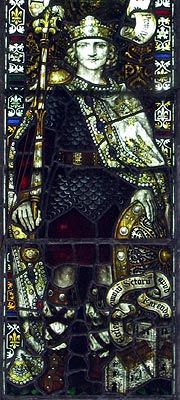
EDWARD [I], called "THE ELDER" to distinguish him from later kings who bore that name, succeeded his father, Alfred, on his death in 899. He was his father's eldest surviving son. His older brother, Edmund, died in his late teens (890). Edward was crowned at Kingston upon the ancient coronation stone of the Wessex kings by Plegmund, the Arch-Bishop of Canterbury. His succession was immediately contested by his cousin, ETHELWALD, the Earl of Wessex, the son of the last Wessex King Ethelred, his father's [Alfred's] older brother, who had come of age, who was the heir of Cerdic's house, of which Alfred's house was a junior line. Ethelwald, whose mother was a Viking princess, found support among his mother's people, the Vikings. He set himself up at York, the Viking capital, as a rival "King of England" in opposition to his cousin. Edward fought Ethelwald for three years before finally defeating and slaying him in battle at Holm, in 902, ending the civil war. Next Edward campaigned against the Vikings who had supported his cousin, and won a victory over them in battle at Tettenhall, Staffordshire, in 910, slaying the three co-kings of Viking/Danish York, however, this did not end the rebellion of the Vikings. Edward attacked an enormous Viking Army again and again which moved across England in 914 and at length drove it out of the country. Edward, in a year of dazzling victories, crushed a series of Viking/Danish armies and re-conquered Essex, East Anglia, and Mercia. He defeated the Earl of Essex, Bertsige, who had supported his cousin, and expelled the Vikings from Essex. He, then, defeated and slew Guthrum II, the Viking-King of East Anglia, in battle at Tempsford, in 916; and, in another battle the next year (917), defeated and killed his son, and expelled another son, and annexed East Anglia to the English state. Edward then proceeded against the Vikings of the "five boroughs" of Viking/Danish Mercia, and defeated a coalition of Viking jarls [earls] of Lincoln, Derby, Nottingham, Stamford, and Leicester. The next year, in 918, Edward marched into English Mercia, deposed its ruler, Elfwyn, Lady of Mercia, and annexed Mercia to the English state. He, afterwards, campaigned in Northumbria against the Vikings there, and forced the submission of Ragnald, the Viking-King of York, who acknowledged his overlordship in 919. Edward thus pacified England after the civil wars that followed King Alfred's death, and re-unified his father's old kingdom. Edward was then able to continue his father's policy to consolidate the new English state by absorbing the Viking settlers, who eventually were "anglicized" over time.
Edward, as his father [Alfred] before him and as his son [Athelstan] after him, was an exceptionally talented soldier, and sometimes has been overshadowed by them though his achievements were on a par with theirs. Edward, too, as his father and as his son, enjoyed a few years of peace before his death after many years of warfare. It was during those years of peace that Edward was able to complete his father's programs and initiate his own programs which in turn were left to his son to complete.
Edward married three times and produced many children. His first wife, Ecgwyn (Egwina) of Mercia [his niece], bore him a son and a daughter. Ecgwyn [the younger sister of Elfwyn, the last Mercian ruler] was the daughter of Edward's sister, Ethelflede, the wife of the Earl of Mercia, and the Church objected to the marriage as incestuous, and forced him to annul the marriage consequently bastardizing her children. Ecgwyn was described as a "noblewoman" by her supporters, but described as a "concubine" by her antagonists. The scandal-mongers of the day even went so far as to claim that she was "a shepherd's daughter." This was a slight on her father, Ethelred, the Earl of Mercia, who as a Mercian prince dispossessed by the Vikings in his youth pretended to be tending the sheep of a Viking jarl [earl] while spying on the Vikings as one of Alfred The Great's militia-officers. His second wife, Elflede (Aelfleda), daughter of Ethelhelm, Earl of East Anglia, bore him three [or four] sons and nine daughters. And, his third wife, Edgive (Eadgifu), daughter of Sigehelm, Earl of Kent, bore him three sons and three daughters. Edward died in 924 [age 55] in the twenty-fifth year of his reign. He was buried at Winchester in the city's new cathedral, that is, the New Minster Abbey [which Alfred begun], so called to distinguish it from the church or Old Minster Abbey next door, which contained Alfred's tomb. His widow, Edgive [third wife], lived on for many years and died in the reign of her grandson.
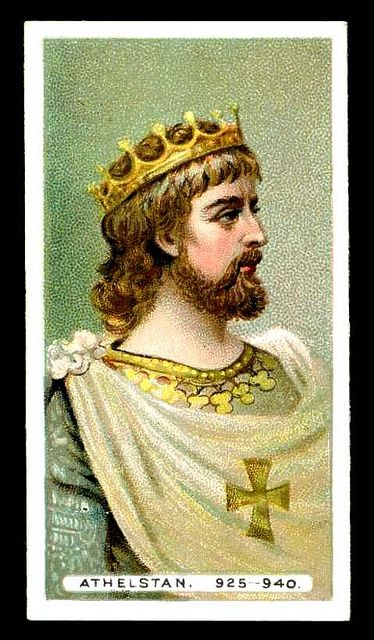
and King of England 927 - 939.
ATHELSTAN "THE GLORIOUS" was the only son of King Edward and his first wife. He was considered illegitimate since the uncle-niece marriage of his parents had been annulled by the Church and there was some opposition to his succession at his father's death. This opposition delayed his coronation for fourteen months after his accession. His half-brother, Elfwerd, the eldest son of King Edward of his second marriage, claimed the throne on his father's death on the basis that Athelstan was illegitimate. Elfwerd had many supporters and was invited by the witanagemot to come and take the crown, however, sixteen days later Elfwerd was murdered at Oxford on his way to Winchester [the capital city] from Bridgnorth [where he lived as a hermit] which cleared the way for Athelstan to assume the throne. Then, another claimant, Alfred, the son of the earlier claimant Ethelwald, the Earl of Wessex, who had opposed his father's [Edward's] succession, raised a rebellion in an attempt to seize the throne. The rebellion, however, was speedily suppressed by Athelstan, and Prince Alfred escaped to Rome where he made a false oath to the pope and was seized by a fit of epilepsy and died within three days. Later, another half-brother, Edwin, the surviving full-brother of Elfwerd, the early claimant, revolted and claimed the throne. He was defeated in battle by Athelstan and drowned while in flight during the rout of his forces. Athelstan, after eliminating opposition by rival claimants, reigned as undisputed king. He was crowned "King of England" at Kingston upon the ancient coronation-stone of the Wessex kings by Wulfstan, the Arch-Bishop of Canterbury.
It was well-known that Athelstan was an avid collector of relics, valuable objects, and memorabilia, for which reason Hugh "The Great," the Duke of France, sent to him three priceless gifts on his betrothal to Athelstan's half-sister in 926, which were: (1) the sword of Constantine "The Great"; (2) the standard [vexillum] of Saint Maurice, which Charlemagne had brought back from Spain; and (3) the "Holy Lance," which hitherto had been part of the collection of the Church of Sens.
Throughout his life Athelstan never lost a battle. He fought the Welsh, the Vikings, and the Scots, and was acknowledged as overlord of Britain by all the island-rulers.
In 926 five Welsh kings, Idwal "Foel" of Gwynedd, Hywel "Dda" of Deheubarth, Llywarch of Powys, Tewdwr of Brecon [Brycheiniog], and Owain of Gwent, met with Athelstan at Hereford where they swore their fealty to him as his vassals and agreed to pay him yearly tribute.
From Hereford Athelstan went to Exeter to meet with King Hoel IX of Cornwall, who refused to submit to the English king, and, in consequence, was taken hostage by Athelstan who occupied Cornwall in 926 and put an end to the thousand-year-old Cornish kingdom. Cornwall was not annexed by England at this time, but was governed as a separate administrative district by English reeves. Cornwall was made an English earldom in 1069 by William "The Conqueror," however, it was not until 1889 during Queen Victoria's reign that Cornwall was officially annexed to England and became an English shire. There were periodic revolts of the Cornish against English rule, one of which occurred later in Athelstan's reign when on the news of the death of Hoel IX, the last King of Cornwall, in 931, while in English captivity, his son, Cynan set himself up as King of Cornwall and rebelled against the English occupation. The Cornish anti-king, Cynan, appears to have been one of the five un-named kings who were slain by Athelstan in the Battle of Brunanburh.
The Viking-King of York [Danish Deira], Sihtric "Caech," recognized Athelstan's suzerainty in 926, and married his sister Edith [his 2nd wife] as part of the peace terms. The alliance did not last long , for the next year, in 927, he repudiated Edith and renounced his oath to Athelstan. The sources differ on what happened next. It appears that Athelstan defeated Sihtric "Caech" in battle, and that Sihtric "Caech" escaped back to York where he was murdered by a faction of the Viking nobles to appease Athelstan. His brother, Godfred, the Viking-King of Dublin, Ireland, was invited by the Viking nobles at York to come and govern as regent for Sihtric's son, Olaf, a minor, begotten of his first wife. The boy-king Olaf "of York" was expelled from York by Athelstan, who repulsed Godfred's invasion of Northumbria, and the Viking kingdom was occupied by English troops. It was during this campaign that Athelstan summoned the northern rulers, who included the King of Scotland among others, to meet with him at Eamont Bridge, near Penrith, in Cumbria, where they swore their allegiance to him as their suzerain. The Viking nobles swore their allegiance to Athelstan, and Northumbria was ruled directly by English reeves for the duration of his reign.
The Scots, the Vikings [or Danes], and Britons rose up in rebellion against English domination in 937, and under the leadership of their kings, Olaf of Dublin, Constantine of Scotland, and Owen of Strathclyde, marched together against Athelstan, however, all were soundly beaten along with their allies, the Irish, Cornish, and Welsh, in the Battle of Brunanburh, one of the decisive battles of British History long celebrated in song and verse, which established the primacy of England in the British Isles. Five kings and eight earls [or jarls] were slain by Athelstan in the battle. The site of the battle is unsure. It is thought by some to have been in Mercia near Nottingham, while some identify Brunanburh with Bromborough on the Mersey Shore of the Wirral River in Cheshire, near Chester; and some have even placed it somewhere on the Solway Firth. The Battle of Brunanburh ended the Celtic struggle for Britain with the Anglo-Saxons. The unification of England under the Wessex Dynasty [which was itself actually non-English but British in origin] and the acceptance of English overlordship in the British Isles however did not go unchallenged in the years to come by the Welsh, Scots, and Irish, until their respective native dynasties eventually inter-married with the English Royal House to produce the "New" British Royal House (1603).
Not only was Athelstan a great military genius but he was also an able administrator and skillful diplomat. He reformed the government at home and made alliances abroad, and extended his influence overseas by the marriages of his half-sisters to foreign royalty. His half-sister Eadgifu married King Charles III "The Simple" of France"; his half-sister Eadhild married Hugh "The Great," the Duke of France; his half-sister Eadgyth married King Otto I "The Great" of Germany; his half-sister Eadgifu married King Louis III "The Blind" of Italy [2nd wife]; his half-sister Elfgive married Conrad I, King of Burgundy [and/or Boleslav II, Duke of Bohemia, which identification has difficulties]. Too, Athelstan had three aunts [who were King Alfred's daughters] who made strategic marriages, who were: Edwina, who married Henri, Duke of Vermandois; Aelfrida, who married Baldwin II, Count of Flanders; and, Elgive, who married Harold "Parc," King of Haithabu.
Athelstan took the style "basileus" which was the title of the eastern Roman emperors, to match his status with the western Holy Roman Emperors whose throne he claimed in 936 in right of his wife, a Carolingian princess, Matilda, (?) the daughter of Zwentiholt, King of Lorraine. It was her second marriage. The marriage of Matilda and Athelstan is recorded in the "Cartularium Saxonicum" (1342), which has been overlooked by modern historians. They had no children; and Matilda returned to the European continent after his death and married a third time.
Athelstan died childless in 939 [age 44/45] in the sixteenth year of his reign. He was buried in Malmesbury Abbey, Wiltshire. Athelstan had acquired international fame, and he died at the peak of his fame. A contemporary said of Athelstan that he "surpassed in fame and praise all earthly kings of his age." His reign was remembered by later annalists as a "Golden Age."
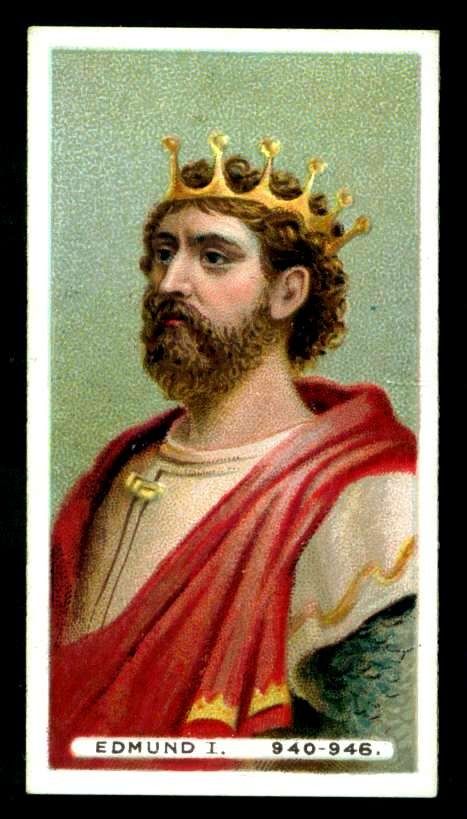
EDMUND I "THE MAGNIFICENT" was the eldest son of King Edward and his third wife. He succeeded his childless half-brother, Athelstan, on his death in 939. Edmund was crowned at Kingston upon the ancient coronation-stone of the Wessex kings by Oda Severus, the Arch-Bishop of Canterbury. Edmund carried on the policies of his predecessors at home, and also conducted an active foreign policy. He has some fame as a law-giver for issuing three sets of laws. The first had to do with church matters, and the second and third were civil codes. The reign of Edmund was dominated by his struggle to preserve the conquests of his predecessors.
In 939 following Athelstan's death, Olaf of Dublin re-invaded Northumbria and established himself again in York as king. In 940 he led his army south and seized the "Five Boroughs" of Danish Mercia. The Vikings of East Anglia, encouraged by Olaf's success, to Edmund's dismay, rebelled against English rule. Talks were held following the stalemate at the indecisive battle of Leicester, and a peace treaty was brokered whereby Edmund recognized Olaf as King of York [Danish Deira], and conceded to him the "Five Boroughs" of Danish Mercia and the Danish territories in East Anglia. Thus, at a stroke Edmund gave away the conquests of his predecessors, however, it was only a temporary set-back. Olaf [Godfred's son] was killed the next year, in 941, while attempting to conquer English Bernicia, and was succeeded in the Kingdom of York [Danish Deira] by [another] Olaf [Sihtric's son]. In 942, Edmund, determined to win back the territories he had lost, undertook a campaign against the Vikings. He showed himself to be a warrior-king like his predecessors. Edmund subdued the rebellious Vikings of East Anglia in 942, recovered the "Five Boroughs" of Mercia in 943, marched north into Northumbria, and by 944 brought Danish Deira back into subjection. Edmund, thus, recovered the territories that he had previously lost and restored the English state.
Edmund begot two sons and a daughter of his first wife, Elgive (Elfgifu), daughter of Byrtsige, a Mercian prince; but had no children of his second wife Ethelflede (Edelffled), daughter of Alfgar, Earl of Wiltshire, divorced wife of King Hywel "Dda" of Deheubarth, who, after his death married Earl Athelstan of East Anglia, her third husband. The potentially great reign of Edmund ended suddenly with his murder by a banished outlaw, who stabbed him to death while dining at a feast with his thanes at Pucklechurch, Gloucestershire, in 946 [age 24/25], in the sixth year of his reign. He was buried in Glastonbury Abbey, Somerset. His two sons of his first wife, namely, Edwig and Edgar, were minors at the time of their father's death, and were passed over in the succession in favor of their uncle Edred, who succeeded his brother as king.
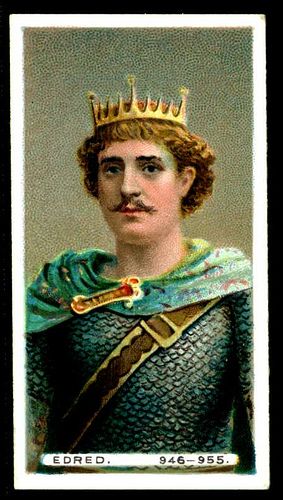
EDRED (EADRED) succeeded to the throne on his brother's [Edmund's] death in 946 over his brother's sons, Edwig and Edgar, who were minors, due to the influence of his mother, Queen Edgive, who brought up Edmund's children. He was crowned at Kingston upon the ancient coronation-stone of the Wessex kings by Oda Severus, the Arch-Bishop of Canterbury. Edred was a warrior-king like his predecessors in spite of some unspecified malady he suffered most of his life. The great event of his reign was the final conquest and annexation of Northumbria. Edred took an army to Northumbria in 954, and defeated its Viking-King, Oeric "Blood-Axe," in battle at Stainmore, Yorkshire, which marks the end of the Viking Kingdom of York [Danish Deira] and the "Danelaw," which was afterwards annexed to the English state. The annexation of Northumbria in 954 permanently united Northern and Southern England under one crown. Edred had long been in bad health and died in 955 [age 32] in the ninth year of his reign. He was buried in the New Minster Abbey at Winchester, also called Winchester Cathedral. His bones are now among those in one of the mortuary chests there. The wife of Edred, whose name is unknown, had died before his succession. Edred had a son Elfric, the crown-prince, who died young during his father's reign, which left Edred childless.
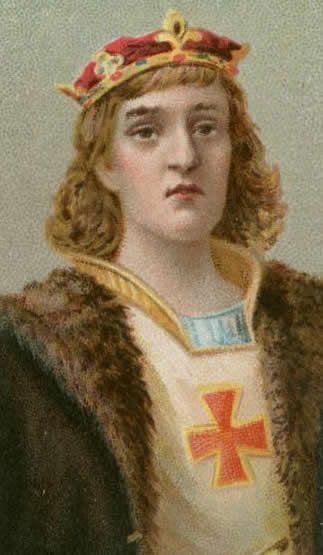
EDWIG (EDWY) "THE FAIR" or "ALL-FAIR" got his epithet due to his striking good-looks. He was the son of the earlier King Edmund who had been passed-over in the succession at the time of his father's death due to his young age. He succeeded his uncle, Edred, who died without surviving issue. Edwig was a minor [age 15] at the time of his succession, and the English Primate, Oda Severus, the Arch-Bishop of Canterbury, served as regent during his minority along with Queen Edgive, the king's grandmother. Edwig came of age the next year, in 956, and was crowned at Kingston [according to custom] by Oda, the Arch-Bishop of Canterbury. His short reign was fraught with scandal and crisis. Edwig was a troublesome youth, and led a dissolute life. He was early seduced and had become besotted on a widow, Ethelgive, who was twice his age, and resolved to cover their connection by marrying her daughter, Elgive. After his coronation Edwig openly lived with the two women at once, which caused an enormous scandal that brought him into conflict with Arch-Bishop Oda. The affair shook the nation. It became public knowledge on the very day of his coronation. That evening, during the coronation-banquet, the king quietly slipped-off with his mistress and her daughter. The Arch-Bishop, Oda, noticing the king's absence, sent two clerics, to enquire after the king and remind him of his duties requesting he return to the banquet. To their horror, they found the king, his mistress, and her daughter, in the king's chamber, all three on a sofa with their clothes disheveled engaged in sordid behavior. The clerics physically separated the king from the two women, dragging the king from their arms, and forced him to return to the banquet. The assembled nobles and clerics at the banquet were dumbfounded with shock and dismay by the actions of the two clerics, and even more appalled by the lack of the king's sense of decorum. The next year, in 957, Edwig married the daughter of his mistress, Elgive, whose father, Ethelred, Earl of Wessex, had been a relative of the royal family. The marriage intensified the growing dissatisfaction with Edwig by the country; sparked a rebellion of the nobles, who conspired to set his pious younger brother Edgar on the throne in place of the licentious Edwig; and set-off a power struggle in the royal court between the king's mother-in-law, Ethelgive [his mistress], and his grandmother, Queen Edgive, supported by Arch-Bishop Oda. The next year, in 958, the Church, under Arch-Bishop Oda, annulled the king's marriage which struck a blow at Edwig's integrity. It made him look foolish, headstrong, and lecherous. The grounds upon which the marriage was annulled was that since Elgive was the king's third-cousin the union was incestuous. The fact that more irregular unions passed without notice suggests that the marriage was dissolved for political reasons. Oda died in 958 and was followed in office in quick succession by the bishops Elfsige, Byrhthelm, and Dunstan. Edwig expelled Dunstan, who led the opposition against him, and banished his grandmother, Queen Elgive, from court. The next year, in 959, the king's mistress, Ethelgive, was cruelly murdered by her enemies, and her daughter, Elgive, the king's ex-wife, committed suicide. King Edwig followed them in death two or three weeks late [age 19] in the fourth year of his reign. His death was a relief to the nation. A later writer speaks of Edwig as having been murdered in a conspiracy of the English nobles. Edwig died childless. He was buried in the New Minster at Winchester in a private service.
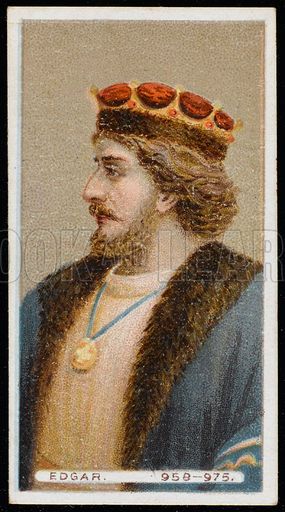
EDGAR I "THE ILLUSTRIOUS" or "THE PEACEABLE" succeeded to the throne on his brother's [Edwig's] early death. He was a youth [age 15] on his succession and was dominated entirely by his grandmother, Queen Edgive, who served as regent during his minority. She recalled Dunstan and restored him as the Arch-Bishop of Canterbury to heal the rift with the Church made by her late grandson. Dunstan, the Arch-Bishop of Canterbury, gained the king's confidence and came to guide him in all things; and was later appointed by Edgar to the office of chancellor. The office of chancellor was then equivalent to the modern office of prime-minister. The death of the king's grandmother, Queen Edgive, in 968, left Dunstan alone as Edgar's chief advisor. Edgar was crowned "King of England" at Kingston by Dunstan, the Arch-Bishop of Canterbury, in 962, in a ceremony attended by all the English earls; but, in 973, Edgar was crowned "King of Britain" or "Albionis Imperator Augustus" ["emperor"] at Bath in another ceremony patterned after that of the Holy Roman Emperors which was attended by all of the island-rulers, including five Welsh kings and the kings of Scotland, Strathclyde, and the Isle of Man.
The reign of Edgar was a period of peace in English History, though Edgar made an expedition against the Vikings in Ireland and occupied Dublin for a while. Too, he made an incursion into Wales, and an expedition to Cumberland is mentioned in the annals also. However, most accounts praise Edgar for the peace he maintained in England during his reign. Edgar was an enlightened king and undertook many reforms that strengthened the legal code that his ancestor Alfred "The Great" had formulated about a century earlier, and thus proved to be a capable ruler. He was firm in rooting-out abuses wherever they were found and in eliminating corruption among local government officials. He appointed sheriffs as royal agents over the shires to control the earls. And, with the aid of the country's bishops Edgar reformed the English Church to bring it in line with ecclesiastical developments on the European continent. Dunstan was more or less responsible with the success of the monastic reform movement, of which Edgar was an enthusiastic patron.
Edgar, of his first wife, Ethelflede "Enede," daughter of Ordmar, Earl of Hertford, begot a son, Edward; and, of his second wife, Alfrida (Elfthryth), daughter of Ordgar, Earl of Devon, and, widow of Earl Ethelwald of East Anglia, had two sons and one daughter. His first-born son of his second wife, Edmund, died young [age 5], which left a single surviving son, Ethelred, by her. Edgar, too, had an illegitimate daughter, Edith, begotten of an affair he had with a maiden after the divorce of his first wife and before his marriage to his second wife. The child's mother, Wulfrida (Wulfryth), refused to marry him and instead entered a nunnery where she spent the remainder of her life. Later commentators found Edgar's marital affairs scandalous; for, according to them, his amorous adventures with Wulfrida was the cause of the breakup of his first marriage; and, his second wife was married when he became romantically involved with her. The gossip of the time was that she murdered her husband to marry the king. Edgar died in 975 [age 31] in the seventeenth year of his reign. He was buried in Glastonbury Abbey, Somerset. His death was followed by disorder over who should succeed him, whether Ethelred [age 7], the son of his second wife and widow, Queen Alfrida, who was supported by the nobles, or Edward [age 13], the son of his late first wife, who was supported by the clergy, which was influenced by the Byzantine practice that one born after their parent's coronation should be preferred over one born before their parent's coronation.
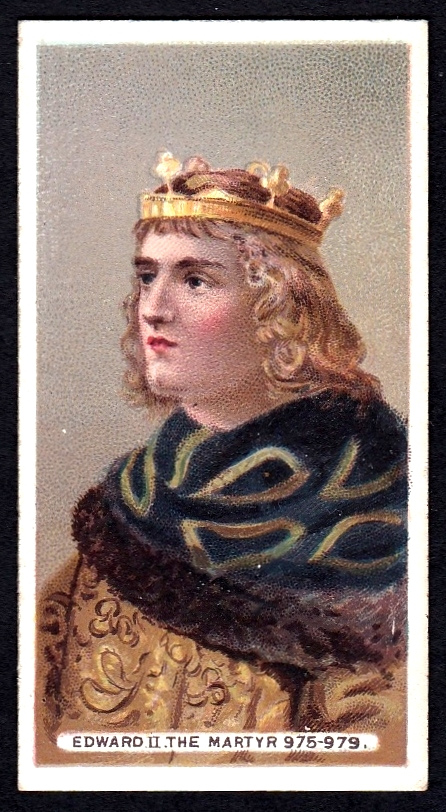
EDWARD [II] "THE MARTYR" was the only child of King Edgar's first marriage. He was made king on his father's death in 975 by Arch-Bishop Dunstan despite opposition from the late king's widow, Queen Alfrida, who felt her son, Ethelred, should have succeeded to the throne. Edward was crowned according to custom at Kingston by Dunstan, the Arch-Bishop of Canterbury. Edward was a minor [age 13] and Arch-Bishop Dunstan governed the country as regent in the king's name. His regency saw rivalry between different factions of the nobles which almost broke-out into civil war. Edward has been described as an ungovernable youth who was spoiled, prone to temper tantrums, and stubborn. His brief reign was marked by a disastrous famine in which many thousands of people starved to death. There was a reaction to the monastic reforms of his father's reign, and many monasteries were pillage by the locals. In a short time the peace, prosperity, and plenty of his father's reign was forgotten, and replaced by disorder, poverty, and lawlessness. Edward was murdered in 979 [age 17] in the fourth year of his reign by his wicked step-mother, Queen Alfrida, who then set her son Ethelred on the throne. Sympathy for his untimely fate gave Edward the epithet "The Martyr." Edward was hastily buried without ceremony at Wareham Abbey, Dorset, but the next year he was re-interred this time with ceremony at Shaftesbury Abbey, Dorset. Later, his bones were removed from the ruins of the abbey and re-interred in Brookwood Cemetery, near Woking, Surrey.
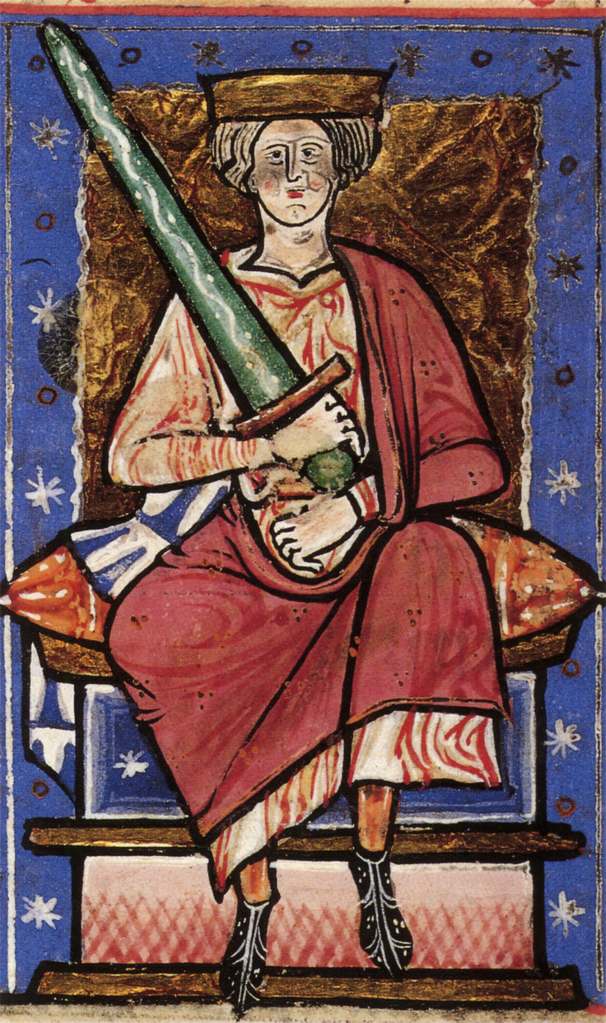
ETHELRED "THE UNREADY" [1st reign] was the son of King Edgar and his second wife, Alfrida. Ethelred was a minor [age 10 or 11] on his succession in 978 and was controlled by his mother, Queen Alfrida, who dismissed Dunstan as chancellor and reigned herself as regent in association with Elfhere, the Earl of Mercia, whom she appointed as the new chancellor. Dunstan lectured the queen and foretold of the calamities which were to befall the country in expiation for Edward's murder, and returned to Canterbury and devoted his remaining years to church matters. The king's mother, Queen Alfrida, was an unscrupulous, treacherous, manipulative woman, who stopped at nothing to achieve her ambitions. She murdered her first husband, Earl Ethelwald of East Anglia, to marry King Edgar as his second wife, when she learned that he was interested in her; and then murdered her step-son, the teenage-king, Edward, the son of Edgar's first wife, to make way for the succession of her son, Ethelred, thus achieving her aims. She dominated the early years of her son's [Ethelred's] reign, though her influence declined after he came of age. Ethelred took the throne in an atmosphere of suspicion, uncertainty, and apprehension, with the nation stunned over the murder of the late king. Ethelred was crowned according to custom at Kingston in 979 by Dunstan, the Arch-Bishop of Canterbury. The reign of Ethelred was one of the most disastrous in English History. Nothing went right for him. Ethelred was a mannerly, handsome, and personable youth; but as he reached manhood displayed an incredible incompetence. Ethelred was under the tutelage of his mother and her circle of friends the first five years of his reign. Earl Elfhere of Mercia, whom his mother had appointed chancellor, led the anti-monastic movement during his regency and succeeded in reducing the wealth, influence, and power of the monasteries, though Ethelred later reversed this. Elfhere also had to deal with the Danes who after thirty years renewed their attacks on England finding the country unprepared and its defenses ineffective. The "burhs" [fortified camps] were still in existence, though in disrepair. There was some refurbishment of the "burhs" undertaken, and the armed-forces were also strengthened, however, these measures failed as a result of bad leadership. Then, suddenly, the Danes ceased their attacks for several years which lulled the English into a false sense of security, and the country's military-preparedness was neglected and allowed to erode more and more.
Ethelred came of age in 983. The death of Earl Elfhere that year left Ethelred free to act on his own. He showed lack of good judgment and listened to bad advice, and consequently was totally incompetent as a ruler. The great men who had surrounded his father gradually died off in the early years of Ethelred's reign. His mother, Queen Alfrida, was the dominant personality at his court. She brought-up Ethelred's children, seven sons and three daughters, of his first wife, Elfgifu (Elgive), the daughter of Ethelbert (Egilbert), Earl of East Anglia, while Ethelred reveled in all sorts of vice during his middle years. Her objection to her son's life-style caused her to be banished from court in 985, but she was forgiven and restored in 990. The queen-mother, Alfrida, in later life, perhaps overtaken by remorse of her past deeds, retired from public life and entered a nunnery where she spent her remaining years. In his later years Ethelred was sobered by the increasing intensity of the Danish attacks on the country which had begun again. These attacks caught Ethelred off-guard by surprise, or "unready," giving Ethelred his epithet. He was only able to put up a feeble defense. His inability to mount any serious challenge to the Danes allowed the invaders to rob, pillage, and burn English towns with little resistance. In 991 the Danes under King Sven "The Dane" or "Fork-Beard" of Denmark completely wiped-out an English army under Byrhtnoth (Beortnoth), the Earl of Essex, in a major battle at Maldon. Ethelred sought to appease the Sven "The Dane" by the payment of an enormous tribute in 994, but many of his councilors feared that it would just encourage him. There were some English earls who threw in their lot with the Danish invaders in their selfish attempts to maintain themselves. This prompted Ethelred to initiate his policy to reorganize the country's provincial governments, which culminated in the "Wantage Code." Ethelred also sought to bind the great nobles of England to him by means of marriage alliances. He married one of his daughters to Earl Athelstan of East Anglia; another daughter was given in marriage to Earl Eadric Streona of Mercia, whom he appointed as his chancellor; and, still another married Earl Uchtred of Northumbria. He, too, contracted the marriage of his eldest son, Athelstan, to one of the daughters of Earl Ethelwerd of Wessex. There is a story that upon the death of his first wife in 991 Ethelred married as his second wife, Elfflede, the daughter of the Danish jarl/earl Thored of Northampton, to secure the earl's loyalty, however, divorced her after her father's death in 992. The marriage produced one daughter. Sven "The Dane" returned to England seeking easy boodle, and made raids all over England from 997 to 1002. Ethelred could do little more than to negotiate a temporary truce. Ethelred used diplomacy this time to neutralize the Danish menace and married the sister of the Viking-Duke Richard II of Normandy, Emma, his third wife; for Normandy was a haven for the Danish Fleet attacking England, and, with Normandy now as an ally, the Danes were obliged to withdraw. Ethelred by Emma had further issue of two sons and one daughter. In 1002, Ethelred, fearing that the Danes were about to seize the kingdom, issued an edict ordering all Danes in England to be put to death on St. Bryce's Day [13 Nov.], and there was a great slaughter throughout the country. The whole-sale genocide of the Danes in England defies imagination. Following this atrocity, the King of Denmark, Sven "The Dane," renewed his attacks on England to avenge the massacre. He converged on England in 1003 with great fury and campaigned almost unchecked up and down the country sacking, looting, and burning towns, until 1007 when Ethelred sued for peace. He agreed to pay the Danish king an immense tribute. Ethelred levied a special tax on his subjects, called the "danegeld," or "Dane-Gold," to raise the tribute. From 1009 to 1012 England was ravaged by Danes under Thorkell "The Tall," one of King Sven's generals, who reeked havoc and destruction all over the country. Faced with this new invasion Ethelred ordered the country's bishops to say prayers after Mass beginning with the third psalm, "O Lord, how they are multiplied who trouble me!" The Vikings sacked Canterbury Cathedral in 1011, and seized, tortured, and murdered the Arch-Bishop, Alphege. In 1013 King Sven "The Dane" returned to England and this time was bent on conquest, and overran the whole country. The English, worn out by years of continuous warfare and heavy tributes, could take no more and offered surrender, which forced Ethelred to flee the country. Ethelred escaped across the English Channel with his family and some retainers just as the Danes entered Winchester [the capital city], and Ethelred found refuge at the court of his wife's brother in Normandy, which left Sven "The Dane" in possession of England.
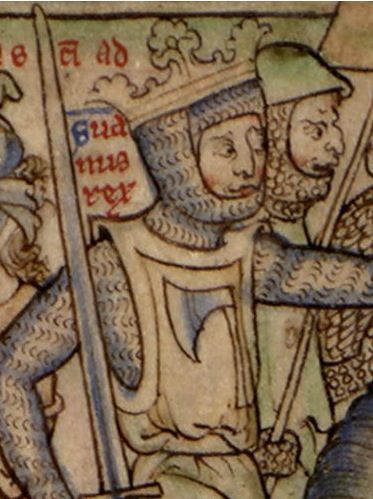
SVEN (SWEYN; SVEGN) "THE DANE" or "FORK-BEARD" proclaimed himself "King of England" on Christmas Day, 1013, after the flight of the English royal family. He was never formally crowned. Sven, a pirate king, was cruel, treacherous, and greedy. The English still regarded Ethelred as their king while he was in exile though in the meantime they were forced to accept Sven as their ruler. The ancestors of Sven "The Dane" were among the Viking-leaders who had earlier conquered the old Anglo-Saxon kingdoms and had held sway in England over the "Danelaw." Sven "The Dane" was a scion of the Volsungs, an old Teutonic family which had come into possession of Denmark through an heiress of its old royal house. The Volsungs derive their name from their fifth-century ancestor Welsinc (Volsung), the grandfather of the Teutonic epic figure Siegfried [or Sigurd] "The Dragon-Slayer," the hero of the "Nibelungenlied," whose ancestry is uncertain but traditionally was a scion of the Scyldings. Sven "The Dane" claimed the English throne as the successor of the Viking-line of England's kings. Too, his grandmother, Tyre "Danebot," was the daughter of the Danish prince Harold "Parc," whose wife, Elgive, was the daughter of England's King Alfred "The Great." Sven "The Dane" of his first wife, Gunhild, the daughter of Duke Mieszko I of Poland, had a son, Cnut (Canute); and, of his second wife, Sigride "Storade" ["The Haughty"], the daughter of Skogul-Toste, a Norwegian jarl, and, the divorced wife of King Eric VII "The Victorious" of Sweden, had a daughter, Estrid, who changed her name to Margaret on her baptism .
The conquest of England was quickly achieved by Sven "The Dane" in only three months, however, his triumph was shortlived due to his early death just six weeks later. He was in his mid-fifties. His death in 1014 [Feb.] broke the spell of terror the Danes had cast over the English people. His body was first buried in York Cathedral among the tombs of the earlier Viking-kings of England, but later was taken back to Denmark and buried in Roskilde Cathedral with the other Kings of Denmark. The Danish Fleet anchored at Southampton acclaimed Sven's son, Cnut, as King of England following his father's death, however, the English nobles recalled Ethelred from exile.

ETHELRED "THE UNREADY" [2nd time] was dispossessed from autumn 1013 to spring 1014 when he was recalled by the English nobles, saying that "no lord was dearer to them than their rightful liege." Ethelred returned to England from exile after the death of Sven "The Dane" and was restored to the throne and reigned a second time, but had to fight to maintain his position against Cnut (Canute), the rival claimant. Ethelred failed to reassert his authority over the English nobles and soon lost control of affairs to quarreling factions. The death of the crown-prince, Athelstan, in 1014, who was King Ethelred's eldest son and heir, made his brother, Edmund, the next heir. Edmund was Ethelred's third son of his first wife, for his second son, Egbert, had died in 1005. However, Queen Emma persuaded Ethelred to designate her son, Alfred "Aetheling," as his successor. He was his eldest son of his third wife. This caused Edmund to revolt against his father, and civil war broke-out among the English while fighting the Danes. Ethelred took to his bed and laid sick and handed over the defense of the realm to his chancellor Eadric Streona, who secretly was negotiating with the Danes. Ethelred died in 1016 [age 48] in the thirty-seventh year of his reign. He was buried in Old St. Paul's Cathedral in London. His tomb was destroyed in the Great Fire of 1087. That was the third St. Paul's on that site. The present St. Paul's is the "fifth" cathedral built on that site. It was built to replace the "fourth" one, which was destroyed in the Great Fire of 1666.
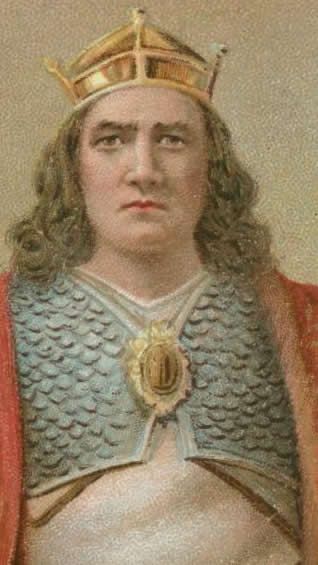
EDMUND II "IRONSIDE" was the son of King Ethelred and his first wife. He succeeded his father on his death in 1016, and was crowned in St. Paul's Cathedral by Lyfing, the Arch-Bishop of Canterbury. His step-mother, Queen Emma, whose children posed a threat to his position, returned to Normandy with her children after Ethelred's death, where she remained until her marriage to Cnut (Canute) when he became king. Edmund from the start had to fight to maintain his position against Canute (Cnut), the rival claimant. Canute, despite set-backs after the death of his father, Sven "The Dane," regrouped his forces and fought no less than six battles against Edmund "Ironside," none of which were clearly decisive. Edmund won the Battle of Sherston, but was defeated by Canute at the Battle of Ashington, and, after the indecisive Battle of Deerhurst both parleyed at a neutral spot on the Isle of Alney, Gloucestershire, and agreed to share the kingdom and divided the country along the old boundary-line between Saxon England [Greater Wessex] and Viking England [the "Danelaw"]. Edmund, however, reigned only seven months [Apr.-Nov.] Year 1016 and was murdered [age 27] by his chancellor, Eadric Streona, who betrayed him and thereupon turned the kingdom over to Canute and became Canute's chancellor, and Canute took sole possession of the country. The despicable Eadric Streona was later executed by Canute who felt like he could not trust him. Edmund II "Ironside" was buried in Glastonbury Abbey, Somerset. Edmund, of his wife, Ealdgyth, daughter of Earl Ethelwerd of Wessex, was survived by two infant sons, Edmund and Edward, who were taken out of the country for safe-keeping. They were hunted by Canute who sent his agents all over Europe looking for them. Nevertheless, they grew up out of his reach in the court of St. Stephen of Hungary. The other possible heirs of the old royal house, Edwig, the surviving full-brother of the late king, and, the late king's half-brothers, Alfred "Aetheling" and Edward "The Confessor," the sons of King Ethelred and Queen Emma, his third wife, were also sought by Canute. Edwig was captured and executed by Canute, but Alfred and Edward were out of Canute's reach at the court of the Duke of Normandy in the safe-keeping of their mother's relatives. Later, Duke Robert of Normandy set sail with a huge fleet against Canute to set Emma's and Ethelred's children [who were under his protection] on the English throne, but the wreck of his ships in a storm put an end to the expedition. Canute made peace with Duke Robert and gave his half-sister, Estrid (Margaret), in marriage to the Norman duke. She was the step-mother of his only son, William "The Conqueror", who became Canute's favorite.
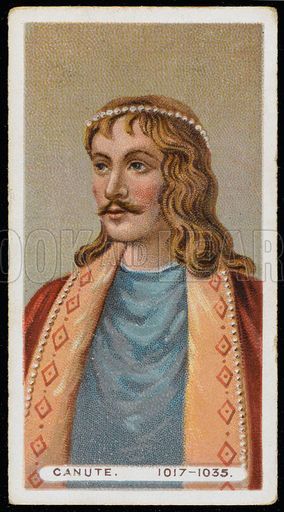
CANUTE (CNUT; KNUT) "THE GREAT" was the son of Sven "The Dane" and his first wife. He was chosen by the Danes in England in 1016 to succeed his father on his father's death, however, at first failed to establish his position. He obtained the throne on the murder of Edmund II "Ironside" by his chancellor, Eadric Streona, who delivered the kingdom over to him. Canute was crowned two months later in St. Paul's Cathedral in London. He made London the capital city of England. At first Canute was not accepted by most of the English nobles. The next year (1017), therefore, Canute systematically executed, imprisoned, or banished many English nobles for almost any reason. He executed his chancellor, Eadric Streona, who formerly was King Edmund's chancellor, out of suspicion that Eadric Streona might betray him as he did his former master. Too, he executed any members of the Old English Royal House he could get his hands on to secure his position. He also imposed a harsh military-style rule in England to prevent any popular uprisings. Canute soon realized that he needed the support of the English nobles to normalize the country and went to great lengths to win those he could over to his side. In 1018 Canute held a conference where the pro-Danish English nobles accepted him as king. They included: Leofric, Earl of Mercia; Siward, Earl of Northumbria; and, Godwine, Earl of Wessex. These three came to be the most powerful nobles in England during Canute's reign.
After a brutal start to his reign Canute became conciliatory once his authority was established and worked to reconcile the Danish conquerors and the conquered English people. The composition of Canute's Court of not only Danes but also English shows that it was his intention to be king of all of England's people, regardless of their race. Canute sought to rule as a traditional English king, and adopted the laws of the Old English Kings, thus, succeeded in winning the respect and loyalty of the conquered English people. His transformation from a barbarian conqueror to a civilized ruler was never fully made, for he retained many of his barbaric traits. There were executions, confiscations of property, banishments, and many acts of injustice which made Canute appear very much to be the barbarian conqueror that he was.
The reign of Canute brought the return of peace and prosperity to England after the privations of thirty years of warfare. Canute spent most of his time in England, which he came to love more than his own Danish homeland, and enthusiastically embraced English culture. Canute held sway not only over England but also was recognized as overlord of Wales, Scotland, and Dublin [Ireland] too, whose kings at one time or another came and swore their fealty to him. Riderch (Rhydderch), the King/Prince of Wales, paid Canute tribute. The "ASC" says that three northern kings paid Canute tribute, who were: Malcolm II, the King of Scotland; Iehmarc, the King of Lothian; and Macbeth, the King of Moray. Too, Sweyn, the King of the Isle of Man, submitted to him also. Canute consolidated his power in England in the years 1016, 1017, and 1018. Then, on the death of his elder brother, King Harold VIII of Denmark, Canute went to Denmark to claim its throne. England remained a separate kingdom and did not become a province of the Danish kingdom when Canute succeeded his brother as King of Denmark in 1019, nor did England become a part of his Scandinavian empire when Canute conquered Norway in 1028 and Sweden in 1030 [to avenge their attacks on Denmark a few years earlier in 1026], and united Denmark, Norway, and Sweden into a great Viking empire. He made regular trips to Denmark and his Scandinavian territories to sustain his North Sea empire.
Once to demonstrate his power, Canute had a chair placed on the sea-shore at the edge of the waves and commanded the rising tide to come no closer, and when it did despite his order he took off his crown and never wore it again. The episode led to Canute's conversion to Christianity. He became a patron of the Church, enforcing tithes, endowing monasteries, and subsidizing at his own expense the tolls of pilgrims on their travels to sacred sites. He also sent English missionaries to Scandinavia to spread the gospel which was then still mostly pagan. Too, accompanied by Lyfing, the Arch-Bishop of Canterbury, Canute visited the pope in Rome where he laid England's tribute to the Holy See on the altar of St. Peter's Basilica. His visit to Rome in 1027 was a political move to meet with other European leaders who were there attending the coronation of the Holy Roman Emperor, Conrad II, with whom Canute made a treaty.
Canute married the widow of King Ethelred "The Unready" of England, namely, Queen Emma, to give his succession to the English throne a sense of continuity as well as to neutralize any possibility that her brother, Duke Richard II of Normandy, might support the claims of Ethelred's sons who were under his protection. Emma, oddly enough, was Canute's cousin on her mother's side; for, her mother, Gunnora, was one of the sisters of Canute's father, Sven "The Dane." Canute, by Emma, begot a son, Hardeknut, and a daughter, Gunhild [baptised Kunigunde]. Canute also had an illegitimate son, Sven (Sweyn; Svegn), by his common-law wife, Elfgifu (Elgive), daughter of Elfhelm, Ealdorman of Northampton, who was formerly the mistress of King [St.] Olaf II of Norway (d1030), by whom she was the mother of another illegitimate son, Magnus, a later claimant to the English throne. Magnus was expelled by Canute in 1028, and, in 1029, found refuge in Russia at the court of Yaroslav I "The Wise," Grand-Duke [King] of Kiev [Russia]. His mother, Elfgifu, was also the mother of Canute's illegitimate son, Harold "Harefoot," Magnus' half-brother. Canute died in 1035 [age 38/40] in the nineteenth year of his reign. He was buried at Winchester in the New Minster along beside the Old English Kings. His bones now lie in one of the mortuary chests there. His empire fell apart after his death due to strife among his family members. His illegitimate son Sven was killed by another son, his lawful son and heir, Hardeknut, whose succession was challenged by his step-brother, Magnus. Hardeknut was proclaimed king on his father's death, however, he was out of the country at the time, and his mother, Queen Emma, Canute's widow, reigned as regent during his absence.
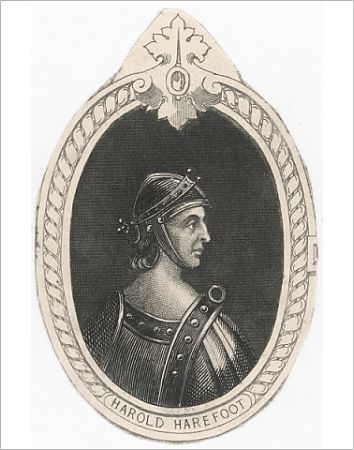
HAROLD I "HAREFOOT", the illegitimate son of Canute by his common-law wife or concubine, was called "Harefoot" for his swiftness of foot. The legal heir, Hardeknut, tarried so long abroad that after a couple of years the English people got tired of waiting for him, and the "witanagemot" chose his half-brother, Harold, to take the throne in his place. Harold banished his step-mother, Queen Emma, who, after failing to oust him, fled across the English Channel and took refuge with relatives on the European continent. Harold was a cruel, reckless, and brutal opportunist. He was crowned at Oxford by the city's bishop. His reign was more or less uneventful except for a dispute with the Church over the ownership of some lands. His succession was challenged by the English heir, Alfred "Aetheling," the eldest son of Queen Emma by her first husband the earlier English king Ethelred "The Unready," who returned to England from exile abroad and claimed the throne, while his half-brother, Hardeknut, joined his mother in exile. He was captured, imprisoned, and blinded so brutally that he died from his wounds. Harold I [age 24] died in 1040 in the third year of his reign. It was thought that he was murdered by the supporters of his half-brother, but it was never proven. He was buried first in the Old Abbey Church of St. Peter [rebuilt by Edward "The Confessor" as Westminster Abbey], however, Hardeknut had his body exhumed, beheaded, and thrown into a marsh. His corpse was found by fishermen who took it to the city's Danish garrison which reburied it in their own cemetery at St. Clement Dane's Church, Strand, in London. He had no issue of his wife, Elgive, however, of his mistress, Alveve, was survived by an illegitimate son, Alboynus (Elfwine), who was brought-up in France and later entered the service of the Church and died a monk at Saint-Foi Abbey, Conques, in Aquitaine.
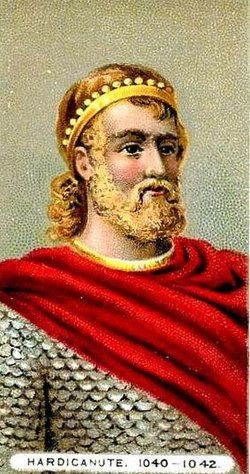
HARDEKNUT came to England on hearing the news of Harold's death in 1040, and was received as king on his appearing. He was crowned at Canterbury Cathedral by Arch-Bishop Eadsige. Hardeknut invited his half-brother, Edward "The Confessor," his mother's son of her first marriage, who was living in Normandy at the time, to come to England and join him at court. Hardeknut designated his half-brother, Edward, as his heir in the absence of his own issue, even though he had earlier made a pact with his step-brother, Magnus, that if either died without issue the other would succeed in their place. Emma, the queen-mother, was a powerful figure at his court. Hardeknut was brutal, malicious, and violent in his rule. He spent most of his short reign engaged in drinking, womanizing, and reveling. His imposition of excessive taxes soon made him unpopular with his subjects. There were riots against the high taxes which were suppressed with brutal viciousness. To this period belongs the episode of Lady Godiva, the wife of Leofric, Earl of Mercia, who protested against the high taxes which her husband was obliged to collect in his domain for the king. It is recorded that all those who had been zealous on Hardeknut's behalf during the usurpation of his half-brother, Harold, now became disloyal to him. In a short period of time he had come to be a much hated king. His execution of some of the nobles further aggravated the situation. Hardeknut suffered a seizure and collapsed while over-indulging himself at a banquet, and died drunk in 1042 [age 23] in the second [or seventh] year of his reign, unwed and without issue. He was very likely poisoned, however, that can not be proven. Hardeknut was buried at Winchester in the New Minster beside his father, Canute. His bones now lie in one of the mortuary chests there. The "ASC" says of Hardeknut that "he never did anything worthy of a king." He was succeeded in England by his half-brother, Edward, while Denmark was seized by his step-brother, Magnus.
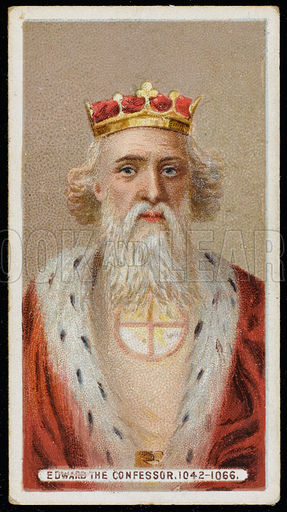
EDWARD [III] "THE CONFESSOR" succeeded to the throne in 1042 [age 37] on the death of Hardeknut, his half-brother. He was chosen by the witanagemot over other possible claimants, among whom was Sven (Sweyn; Svegn), Hardeknut's cousin, the son of Canute's half-sister, Estrid, who was next in line. Hardeknut had a sister, Gunhild, but she had no sons, only a daughter, and, though England had been ruled by queens before, during this period of history the rule of a woman in her own right was unthinkable. There was still an active Danish party but the influence of the English nationalists prevailed and Edward was chosen. The succession of Edward represented the restoration of the Old English Royal House after twenty-six years of foreign Danish kings on the English throne. The queen-mother, Emma, was a transitional figure in smoothing the succession from one dynasty to another, from Hardeknut, her son by her second husband the Danish king Canute "The Great," to Edward, her son by her first husband the English king Ethelred "The Unready," even though she backed the claims of her step-son, Magnus, who was her favorite. Magnus, however, was busy in Denmark attempting to consolidate his position there and was unable to press his claim to the English throne at the time. Edward was crowned at Winchester Cathedral by Eadsige, the Arch-Bishop of Canterbury.
Though Edward was a prince of the old English line, he was culturally Norman since he had been reared by the relatives of his Norman mother, Queen Emma, and had been an exile in Normandy most of his life. Edward had inherited a court made up almost entirely of Anglo-Danish statesmen, the remnant of another age and another royal line. It was not surprising, under the circumstances, that Edward turned for support to those from the country in which he spent most of his life, that is, the French-speaking Normans, and surrounded himself with Norman ministers, which offended the country's great magnates as well as all the political factions.
Edward built a palace and an abbey at the West-End of London. The palace, called Westminster Palace, was the main residence of the English kings from Edward "The Confessor" to Henry VIII or Edward VI, in whose time the palace was entirely taken over by government offices. The king's court, which evolved into parliament over the years, still today uses the palace as its meeting place as if it were still the monarch's residence. The abbey, built on the site of an old Roman church, was originally called St. Peter's, but, over-shadowed by the name and prestige of the other St. Peter's in Rome, came to be called Westminster Abbey.
Edward was a soft, devout, pious man. He was at heart more of a Norman-French monk than an English king. His reputation for saintliness made him a legendary figure during the Middle Ages. He got his epithet "The Confessor" for the special masses he held to confess the sins of the nation. Edward, a weak ruler, whose inclinations were directed towards a religious life, left the affairs of state to his ministers, which allowed him to pursue his own interests. Hence, during the early years of his reign England was dominated by the country's three great earls, Godwin of Wessex, Leofric of Mercia, and Siward of Northumbria. Earl Godwin of Wessex had become the most powerful man in England during Canute's reign, and as Edward's chancellor during his middle years was the real ruler of the country. As the years went by King Edward grew more and more religious, and in the later years of his reign he devoted himself entirely to religious matters. The personality of Edward changed later in his life, and he came to be quite mystical in his old age. His subjects came to regard him with superstitious awe. It came to be believed that Edward had the divine gift of healing, and people came from all over the country and brought their sick to King Edward for him to heal, and the service of "the king‘s touch" was added to the cult of the British Monarchy, and it remained so for centuries to come until the accession of the Hanoverians.
Edward married Edith, the daughter of Earl Godwin of Wessex. Godwin, who felt threaten by the king's Norman favorites at court, pressured Edward to marry his daughter to bolster his waning influence. The marriage of Edward and Edith was childless, and in the absence of his own issue Edward was persuaded by the ambitious Norman faction in his court to designate as his heir his foster-son, William of Normandy, an orphan, whom Edward had cared for during his exile in Normandy after the deaths of the boy's parents. Edward sent for William who temporarily resided at the English court. In 1051 Edward fell-out with Godwin over the adoption of William as his heir, and replaced him as chancellor with Robert Champart, a Norman favorite. Edward also fell-out with his mother, Queen Emma, who supported Godwin, and expelled her from court too. Then, for a year, the king's Norman favorites dominated the English court. They held all the highest offices and were the king's closest advisors. Robert of Jumieges, another Norman favorite, was appointed Arch-Bishop of Canterbury. In 1052, Godwin rallied his supporters and staged a coup, and forced Edward to reinstate him as chancellor. The queen-mother, Emma, was also restored of her rights and privileges as well as her place at court, however, shortly after, she retired to St. Mary's Convent at Winchester where she died soon afterwards. Godwin, once back in office, expelled William of Normandy, who returned to the European continent, and also the king's Norman appointees, whom he replaced with his own nominees. Godwin, however, died the next year, in 1053, and was succeeded in office as chancellor by his son, Harold, who then became the power behind the throne.
To settle the question of the succession, negotiations were begun in 1054 to bring Edward "The Exile" back to England from exile. Edward "The Exile" was the son of the king's late half-brother, namely, King Edmund II "Ironside." The older brother of Edward "The Exile," namely, Edmund, was killed in 1046 helping another exile, Prince Andrew of Hungary, to gain the Hungarian throne. Edward "The Exile" was residing at the court of Yaroslav I "The Wise," Grand-Duke [King] of Kiev [Russia], when the Holy Roman Emperor Henry II negotiated a match with his niece, Agatha, in an attempt to form an English-German-Russian alliance to combat Scandinavian expansion. She journeyed to Russia, where she married the English prince. Edward and Agatha had three children, a boy, Edgar, and two daughters, Margaret and Christina. They settled in Hungary in 1046, and it was there that an embassy dispatched by Edward "The Confessor" found them. After several delays, the royal party finally reached England, however, a few days after arriving in the country Edward "The Exile" was murdered by agents of the pro-Norman faction at court. The death of Edward "The Exile" in 1057 was a severe blow to the nationalist party; and William of Normandy was invited back to England that year by King Edward who compelled the English nobles to swear an oath to William acknowledging him as the heir to the throne. The only other possible heir was the young son of Edward "The Exile," Edgar "Aetheling," who was a small child of three years.
Edward suffered a stroke in late 1065 and died early in 1066 [age 62] in the twenty-fourth year of his reign. His death had been expected for some time, and the "witanagemot" held meetings during the dying king's last days to work out plans to declare the king's great-nephew, Edgar, as the successor, and Earl Harold to serve as regent until Edgar came of age. Those plans were shelved the day after the king's death when Earl Harold by a coup usurped the throne.
The tomb of Edward "The Confessor" in Westminster Abbey is the abbey's central shrine. His widow, Edith, retired into a convent and later died a nun. There grew over the following years a cult of Edward "The Confessor," who, in 1161, was canonized a saint by the Church. His throne, St. Edward's Throne, is the coronation-chair on which English monarchs are inaugurated during their coronation; and, his crown, St. Edward's Crown [so-called, was actually Alfred The Great‘s crown], was used at coronations to crown the English kings until its destruction by Oliver Cromwell during the English Republic (1650s) who thought that the monarchy had been permanently overthrown. The modern replica of St. Edward's Crown was made from the scrap metal of the original crown.
The death of the childless King Edward "The Confessor" in 1066 was followed by a disputed succession. There were several possible claimants. At home, there were: (a) Edgar "Aetheling" [only son of Edward "The Exile," the rightful heir], who was heir of Alfred's House; and (b) Harold of Wessex, who was heir of Cerdic's [or Egbert's] house; who both had claims to the throne as heirs of the old Anglo-Saxon line of England's kings; and abroad, there were: (c) King Harald III "Hardrada" of Norway [whose third wife, Ellisif, or Beatrix, was the only child of King Hardeknut's sister], who claimed the throne as heir of Magnus' title; (d) King Sven II of Denmark [son of King Canute's half-sister, Estrid, and her first husband], who was considered by the Danish earls in England to be the heir; and (e) William of Normandy [step-son of King Canute's half-sister, Estrid, and her second husband], who claimed the throne as the "adopted son" of Edward "The Confessor"; who three each had claims to the English throne as the heirs of the old Viking-line of England's kings.
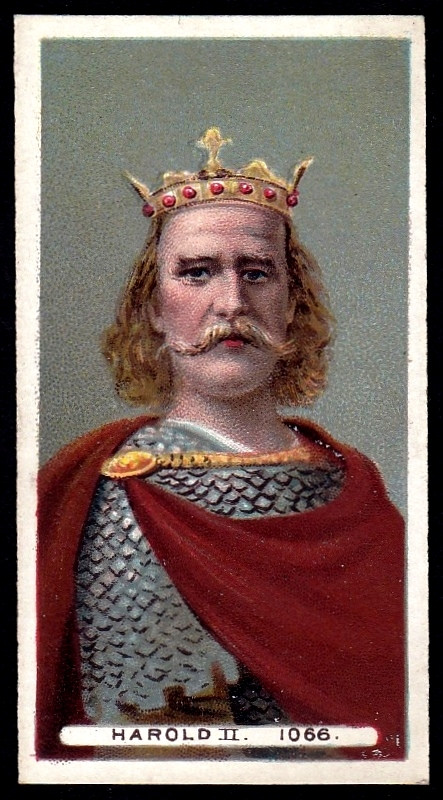
HAROLD II usurped the throne the day after King Edward's death by-passing the late king's great-nephew, Edgar "Aetheling," a minor, and reigned as Harold II in prejudice of Edward's adoptive heir, William of Normandy, who regarded Harold's actions as treachery and prepared to invade. Harold was very popular and held in high esteem by the English people. His succession was upheld by the nobles who elected him king, even though he was not in the line of succession. Harold, on his father's side, was descended from a collateral line of the royal house, and, therefore, was a distant cousin of the late king, hence, he too was an heir of the old Anglo-Saxon bretwaldas; while, on his mother's side, was related to the previous usurping Danish line of kings. Harold was tall, strong, and handsome; and a leader of proven ability as shown by his generalship in campaigns in Wales, whose king he defeated in battle (1063); on the continent fighting side-by-side with William of Normandy against Duke Conan II of Brittany (1064); and, in Northumbria whose oppressive earl he expelled and replaced with another (1065). Harold II was crowned in Westminster Abbey by Stigand, the Arch-Bishop of Canterbury, the afternoon of the sameday of the funeral of Edward "The Confessor" that morning. His succession was challenged by other claimants and therefore Harold had to fight to maintain his position. The pope did not recognize the election of Harold and gave the plans of William of Normandy to invade England the status of a crusade.
Harold mustered an army and encamped on the Isle of Wight the whole summer of 1066 anticipating an invasion by William of Normandy, who was gathering an army and collecting a fleet of ships across the English Channel but the prevailing winds kept his fleet from sailing. Then, with autumn approaching, Harold disbanded the army and returned to London. There he received news that another claimant, King Harald "Hardrada" of Norway, had landed on the northeast coast of England and was on the march against him. Harold hastily reassembled his army and made a forced march in five days when he overtook the Norse invaders. Harold defeated and slew Harald "Hardrada" of Norway in battle at Stamford Bridge in Northumbria [25 Sep.]. The remnants of the Norwegian Army fled back to their ships and sailed back home. No sooner had Harold turned back the Norse invasion than news came that William of Normandy had landed on the southern coast of England with another invasion force [29 Sep.]. Harold regrouped his exhausted army and marched south again with amazing speed to oppose William and in six days was back in London. He waited there a few days for scouts to return with information on the movements of the Norman invaders. Harold then marched against William and met up with him at Senlac, near Hastings, in Sussex. The English were confident of victory having just defeated one invading army and spent the night before battle in drunken merrymaking, while across the valley the Normans in their camp passed the night in quiet devotions. The next day the English and the Normans fought it out from sunrise to sunset with the outcome still unsure. The battle was fierce and "there was great slaughter on both sides." Halley's Comet passed the earth and streaked across the sky during the battle, which is recorded on the Bayeux Tapestry. The tide of battle turned about sunset when Harold was struck in an eye by an arrow and in the ensuing confusion the English broke ranks. Towards evening a band of Norman knights broke through the royal household troops who stayed and died to a man defending their wounded king. Harold was hacked to death while bent over his shield bleeding from his eye, along with his bodyguard who lay dead round their fallen king. His dead body at day's end on the battlefield was a symbol that the Old English Era was gone. By nightfall the Normans had completely beaten the English in the Battle of Hastings [14 Oct.]. Night covered the flight of the remnant of the English Army after the battle. Harold II fell in battle in 1066 [age 44] having reigned only ten months [Jan.-Oct.]. His body, when recovered, was virtually unrecognizable, and his mistress was summoned to identify it. The late king was first buried under a pile of rocks on the battlefield and was later removed by some friends and buried in Waltham Abbey, Essex. The abbey fell into ruins after the dissolution of the monasteries and at some time Harold's body was re-interred in Holy Trinity Church, Bosham, Sussex. Harold II, of his queen, Ealdgyth, daughter of Earl Leofric of Mercia and Lady Godiva, and, widow of King Gruffydd I of Wales, was survived by a son, Harold, born posthumously soon after his father's death. He was reared on the continent in exile and was still alive in 1098 but it is not known what became of him. His mother, Queen Ealdgyth, King Harold's widow, was placed in a convent by William where she later died a nun. Harold was also survived by six illegitimate sons and two illegitimate daughters of his long-time mistress, Eadgyth "Swanneshals" ("Swan-Neck"). His illegitimate sons after Hastings fled into exile. They later returned and led an uprising against William in 1069 but were defeated and fled back into exile. Harold II is often portrayed as the last Saxon king of England but that is untrue, though his heroic stand and death in battle against foreign conquerors does seem to be a fitting end to the age.

EDGAR II "AETHELING", the only son of Edward "The Exile," was regarded by many as the rightful heir. He was proclaimed king by the witanagemot in London after the death of Harold II at Hastings in 1066. There is no record that Edgar was ever crowned, however, Stigand, the Arch-Bishop of Canterbury, was one of his supporters and may have crowned him for he later adamantly refused to crown William regarding him as an usurper. Edgar was a minor [age 13] on his succession, and the nobles formed a regency council to govern in his name. It seemed to the English leaders that London could be held while a second army was raised, and there was still the English Navy which could move into the English Channel and cut-off William's supply-line with his home-base. But, there was little time. The deaths of many of the country's great nobles at Hastings greatly impaired any capacity for coordinated resistance, and William had already dispatched advance-teams to go ahead of him to arrest local leaders. William marched on London with little delay following the Battle of Hastings. He besieged the city, burned its surrounding suburbs, and the city's panic-stricken citizens threw open the city's gates to him. The citizens of London stood and watched in sullen silence as WILLIAM "THE CONQUEROR" marched into the city at the head of the Norman Army. The boy-king, Edgar II, had departed London with his ministers just before the Normans cut the roads out of the city, however, the royal party was captured at Berkhamstead by a Norman patrol and was brought back to London to appear before William. Edgar II was obliged to abdicate in William's favor having reigned for only two months [Oct.-Dec.], Year 1066, and William took possession of the English kingdom. He was held in custody by William along with his mother and two sisters. William sought to marry Edgar's older sister, Margaret, even though he was already married to the daughter of a Flemish count, however, she repudiated him. Margaret with her sister Christina along with their brother, the ex-king, Edgar "Aetheling," together with their mother, Agatha, escaped confinement and made their way to Scotland where they were given refuge by the Scottish king. In response, William took an army to Scotland and forced its king, Malcolm III, to eject Edgar from his realm.
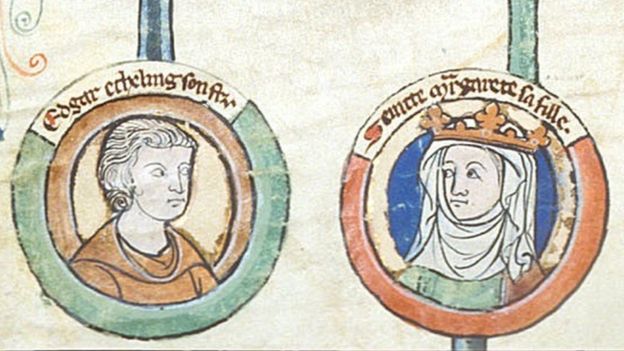
Edgar went abroad into exile, his sister Margaret married the Scottish king, and his other sister Christina entered a convent and became a nun. The ex-king, Edgar, returned to England after coming of age in 1069 and rallied the country against the Norman conquerors but was defeated in battle by William ending all hopes for a restoration. Edgar "Aetheling" escaped back to the European continent and over the next few years wandered around Europe visiting its various capitals. He outlived William and was alive during the reigns of his sons, William II "Rufus" and Henry I "Beauclerc." Edgar "Aetheling" became an adventurer and fought in the First Crusade, and entered Jerusalem with the crusade's leader, Godfrey of Bouillon, in 1099, side-by-side with Robert "Courthose," the Norman heir, who was William's estranged eldest son, with whom he had come to be friends. In 1106 Edgar was taken prisoner at Tinchebrai fighting on the side of Robert "Courthose" against his brother, King Henry I of England, who had by-passed him in the succession. Edgar was brought back to England and was briefly imprisoned by Henry I, who pardoned and release him under the persuasion of his wife, Matilda (Edith), who was Edgar's niece. Edgar, then, retired onto an estate in Hertfordshire which Henry I gave to him. Edgar "Aetheling," the last male-line descendant of Alfred "The Great," died childless in 1126/1127 [age 74], almost forgotten, after which die-hard English patriots looked to the children of Edgar's sister Margaret as the heirs of the old royal race, and they were claimants to the English throne and rivals of the Norman line of England's kings. The marriage of Margaret's daughter, Edith (Matilda), to King Henry I united the Norman and Saxon [English] dynasties in their off-spring and effectively restored the old royal line to the throne.
Meanwhile, William "The Conqueror" was about England crushing opposition and wiping-out resistance. He embarked on a broad path of destruction as he marched through England to force the country into submission. There were uprisings all over England against the Norman conquerors. The country's great earls, Wulfnoth of Wessex, Edwin of Mercia, and Waltheof II of Northumbria, each led rebellions which were suppressed by William with terrible severity. An uprising led by Hereward "The Wake" [Harold II's nephew], a claimant to the throne, was ruthlessly crushed by William in 1071 which virtually ended English resistance. The devastation of the country by William during the Norman Conquest, that is, destroying whole towns and villages, as well as crops, herds, and flocks, and laying waste to the English countryside, were unnecessary brutal acts of savagery on William's part which caused thousands of people to die from exposure and starvation. More than 100,000 people died the winter of 1069 as a result of William's vengeance. So ends the Old English Era, and thus begins the Medieval Era.
![]()
![]()
Disclaimer:
Some material presented will contain links, quotes, ideologies, etc., the contents of which should be understood to first, in their whole, reflect the views or opinions of their editors, and second, are used in my personal research as "fair use" sources only, and not espousement one way or the other. Researching for 'truth' leads one all over the place...a piece here, a piece there. As a researcher, I hunt, gather and disassemble resources, trying to put all the pieces into a coherent and logical whole. I encourage you to do the same. And please remember, these pages are only my effort to collect all the pieces I can find and see if they properly fit into the 'reality aggregate'.
Personal Position:
I've come to realize that 'truth' boils down to what we 'believe' the facts we've gathered point to. We only 'know' what we've 'experienced' firsthand. Everything else - what we read, what we watch, what we hear - is what someone else's gathered facts point to and 'they' 'believe' is 'truth', so that 'truth' seems to change in direct proportion to newly gathered facts divided by applied plausibility. Though I believe there is 'truth', until someone representing the celestial realm visibly appears and presents the heavenly records of Facts And Lies In The Order They Happened, I can't know for sure exactly what "the whole truth' on any given subject is, and what applies to me applies to everyone. Until then I'll continue to ask, "what does The Urantia Book say on the subject?"
~Gail Bird Allen
![]()
![]()













-
Urantia Book, 44:0.11 - The Celestial Artisans
Never in your long ascendancy will you lose the power to recognize your associates of former existences. Always, as you ascend inward in the scale of life, will you retain the ability to recognize and fraternize with the fellow beings of your previous and lower levels of experience. Each new translation or resurrection will add one more group of spirit beings to your vision range without in the least depriving you of the ability to recognize your friends and fellows of former estates.
-
Princess Bride 1987 Wallace Shawn (Vizzini) and Mandy Patinkin (Inigo Montoya)
Vizzini: HE DIDN'T FALL? INCONCEIVABLE.
Inigo Montoya: You keep using that word. I do not think it means what you think it means. -
Urantia Book, 117:4.14 - The Finite God
And here is mystery: The more closely man approaches God through love, the greater the reality -- actuality -- of that man. The more man withdraws from God, the more nearly he approaches nonreality -- cessation of existence. When man consecrates his will to the doing of the Father's will, when man gives God all that he has, then does God make that man more than he is.
-
Urantia Book, 167:7.4 - The Talk About Angels
"And do you not remember that I said to you once before that, if you had your spiritual eyes anointed, you would then see the heavens opened and behold the angels of God ascending and descending? It is by the ministry of the angels that one world may be kept in touch with other worlds, for have I not repeatedly told you that I have other sheep not of this fold?"
-
Urantia Book, Foreword - 0:12.12 - The Trinities
But we know that there dwells within the human mind a fragment of God, and that there sojourns with the human soul the Spirit of Truth; and we further know that these spirit forces conspire to enable material man to grasp the reality of spiritual values and to comprehend the philosophy of universe meanings. But even more certainly we know that these spirits of the Divine Presence are able to assist man in the spiritual appropriation of all truth contributory to the enhancement of the ever-progressing reality of personal religious experience—God-consciousness.
-
Urantia Book, 1:4.3 - The Mystery Of God
When you are through down here, when your course has been run in temporary form on earth, when your trial trip in the flesh is finished, when the dust that composes the mortal tabernacle "returns to the earth whence it came"; then, it is revealed, the indwelling "Spirit shall return to God who gave it." There sojourns within each moral being of this planet a fragment of God, a part and parcel of divinity. It is not yet yours by right of possession, but it is designedly intended to be one with you if you survive the mortal existence.
-
Urantia Book, 1:4.1 - The Mystery Of God
And the greatest of all the unfathomable mysteries of God is the phenomenon of the divine indwelling of mortal minds. The manner in which the Universal Father sojourns with the creatures of time is the most profound of all universe mysteries; the divine presence in the mind of man is the mystery of mysteries.
-
Urantia Book, 1:4.6 - The Mystery Of God
To every spirit being and to every mortal creature in every sphere and on every world of the universe of universes, the Universal Father reveals all of his gracious and divine self that can be discerned or comprehended by such spirit beings and by such mortal creatures. God is no respecter of persons, either spiritual or material. The divine presence which any child of the universe enjoys at any given moment is limited only by the capacity of such a creature to receive and to discern the spirit actualities of the supermaterial world.
-
Urantia Book, 11:0.1 - The Eternal Isle Of Paradise
Paradise is the eternal center of the universe of universes and the abiding place of the Universal Father, the Eternal Son, the Infinite Spirit, and their divine co-ordinates and associates. This central Isle is the most gigantic organized body of cosmic reality in all the master universe. Paradise is a material sphere as well as a spiritual abode. All of the intelligent creation of the Universal Father is domiciled on material abodes; hence must the absolute controlling center also be material, literal. And again it should be reiterated that spirit things and spiritual beings are real.
-
Urantia Book, 50:6.4 - Planetary Culture
Culture presupposes quality of mind; culture cannot be enhanced unless mind is elevated. Superior intellect will seek a noble culture and find some way to attain such a goal. Inferior minds will spurn the highest culture even when presented to them ready-made.
-
Urantia Book, 54:1.6 - True And False Liberty
True liberty is the associate of genuine self-respect; false liberty is the consort of self-admiration. True liberty is the fruit of self-control; false liberty, the assumption of self-assertion. Self-control leads to altruistic service; self-admiration tends towards the exploitation of others for the selfish aggrandizement of such a mistaken individual as is willing to sacrifice righteous attainment for the sake of possessing unjust power over his fellow beings.
-
Urantia Book, 54:1.9 - True And False Liberty
How dare the self-willed creature encroach upon the rights of his fellows in the name of personal liberty when the Supreme Rulers of the universe stand back in merciful respect for these prerogatives of will and potentials of personality! No being, in the exercise of his supposed personal liberty, has a right to deprive any other being of those privileges of existence conferred by the Creators and duly respected by all their loyal associates, subordinates, and subjects.
-
Urantia Book, 54:1.8 - True And False Liberty
There is no error greater than that species of self-deception which leads intelligent beings to crave the exercise of power over other beings for the purpose of depriving these persons of their natural liberties. The golden rule of human fairness cries out against all such fraud, unfairness, selfishness, and unrighteousness.





